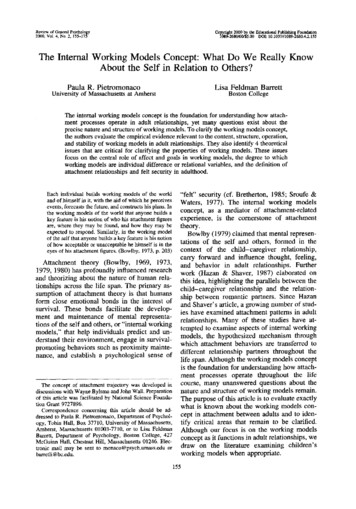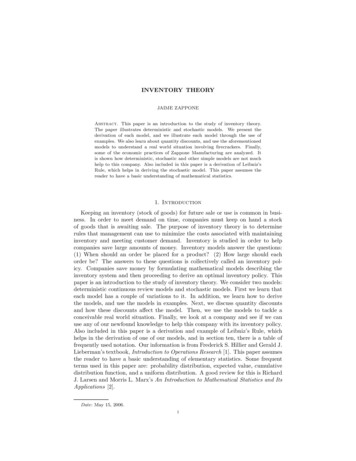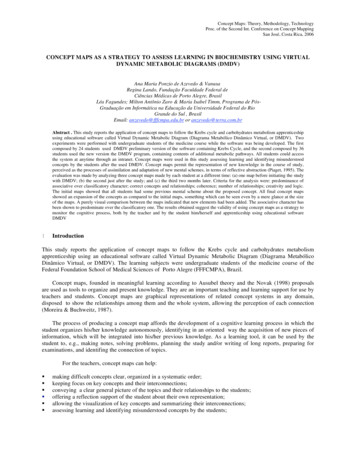
Transcription
Review of General Psychology2000, Vol. 4, No. 2, 155-175Copyright 2000 by the Educational Publishing Foundation1089-2680/00/ 5.00 DOI: 10.1037111089-2680.4.2.155The Internal Working Models Concept: What Do We Really KnowAbout the Self in Relation to Others?P a u l a R, P i e t r o m o n a c oUniversity of Massachusetts at AmherstLisa Feldman BarrettBoston CollegeThe internal working models concept is the foundation for understanding how attachment processes operate in adult relationships, yet many questions exist about theprecise nature and structure of working models. To clarify the working models concept,the authors evaluate the empirical evidence relevant to the content, structure, operation,and stability of working models in adult relationships. They also identify 4 theoreticalissues that are critical for clarifying the properties of working models. These issuesfocus on the central role of affect and goals in working models, the degree to whichworking models are individual difference or relational variables, and the definition ofattachment relationships and felt security in adulthood.Each individual builds working models of the worldand of himself in it, with the aid of which he perceivesevents, forecasts the future, and constructs his plans. Inthe working models of the world that anyone builds akey feature is his notion of who his attachment figuresare, where they may be found, and how they may beexpected to respond. Similarly, in the working modelof the self that anyone builds a key feature is his notionof how acceptable or unacceptable he himself is in theeyes of his attachment figures. (Bowlby, 1973, p, 203)Attachment theory (Bowlby, 1969, 1973,1979, 1980) has profoundly influenced researchand theorizing about the nature o f human relationships across the life span. The primary assumption o f attachment theory is that humansform close emotional bonds in the interest ofsurvival. These bonds facilitate the development and maintenance of mental representations of the self and others, or "internal workingmodels," that help individuals predict and understand their environment, engage in survivalpromoting behaviors such as proximity maintenance, and establish a psychological sense ofThe concept of attachment trajectory was developed indiscussions with Wayne Bylsma and John Wall. Preparationof this article was facilitated by National Science Foundation Grant 9727896.Correspondence concerning this article should be addressed to Paula R. Pietromonaco, Department of Psychology, Tobin Hall, Box 37710, University of Massachusetts,Amherst, Massachusetts 01003-7710, or to Lisa FeldmanBarrett, Department of Psychology, Boston College, 427McGuinn Hall, Chestnut Hill, Massachusetts 01246. Electronic mail may be sent to monaco@psych.umass.edu orbarretli@bc.edu."felt" security (cf. Bretherton, 1985; Sroufe &Waters, 1977). The internal working modelsconcept, as a mediator of attachment-relatedexperience, is the cornerstone of attachmenttheory.Bowlby (1979) claimed that mental representations of the self and others, formed in thecontext of the c h i l d - c a r e g i v e r relationship,carry forward and influence thought, feeling,and behavior in adult relationships. Furtherwork (Hazan & Shaver, 1987) elaborated onthis idea, highlighting the parallels between thec h i l d - c a r e g i v e r relationship and the relationship between romantic partners. Since Hazanand Shaver' s article, a growing number of studies have examined attachment patterns in adultrelationships. Many of these studies have attempted to examine aspects o f internal workingmodels, the hypothesized mechanism throughwhich attachment behaviors are transferred todifferent relationship partners throughout thelife span. Although the working models conceptis the foundation for understanding how attachment processes operate throughout the lifecourse, many unanswered questions about thenature and structure o f working models remain.The purpose o f this article is to evaluate exactlywhat is known about the working models concept in attachment between adults and to identify critical areas that remain to be clarified.Although our focus is on the working modelsconcept as it functions in adult relationships, wedraw on the literature examining children'sworking models when appropriate.155
156PIETROMONACOAND FELDMANBARRETI'The Internal Working Models ConceptA central tenet of attachment theory (Bowlby,1969, 1973) is that people develop mental representations, or internal working models, thatconsist of expectations about the self, significant others, and the relationship between thetwo. Working models are thought to includespecific content about attachment figures andthe self that is stored within a well-organizedrepresentational structure (Bowlby, 1980;Bretherton, 1985, 1990; Collins & Read, 1994).Furthermore, their content is believed to includeknowledge about the details (e.g., what happened, where, and with whom) of interpersonalexperiences as well as the affect (e.g., happiness, fear, and anger) associated with those experiences (Bretherton, 1985). Working modelsalso are assumed to involve processes that influence what information individuals attend to,how they interpret events in their world, andwhat they remember. Furthermore, these processes are hypothesized to operate primarilyoutside of conscious awareness (Bowlby, 1980;Bretherton, 1985, 1990; Main, Kaplan, & Cassidy, 1985). Because they work on the principleof assimilation, directing both attention and behavior, working models tend to remain stableover time, although they may change undersome conditions (Bowlby, 1973). In the sections to follow, we elaborate on these assumptions and evaluate the evidence relevant toworking models.Content of Working ModelsTheory. Bowlby (1973) proposed that people hold working models of the self and others,and other theorists have elaborated on this idea(Bartholomew, 1990; Bartholomew & Horowitz, 1991). Working models of self are thoughtto arise as individuals interact with close others(Cooley, 1902; Markus & Cross, 1990; Mead,1934). In particular, they are believed to derivefrom beliefs about how acceptable the self is inthe eyes of early attachment figures, as gaugedfrom the responsiveness of those figures. Children who have attachment figures who arereadily available, responsive, and reliable areassumed to develop a representation of the selfas acceptable and worthwhile. Those who haveinconsistent or unresponsive attachment figuresare assumed to develop a view of self as unac-ceptable and unworthy (for a review, seeCassidy, 2000). Working models of others arehypothesized to include expectations about whowill serve as attachment figures (i.e., whom toturn to when in need of security), how accessible those figures are, and principally about howthey will respond when needed (Main et al.,1985).Attachment styles. People show differentattachment styles that reflect their different interpersonal experiences. Work focusing on parent-child attachment (see Ainsworth, Blehar,Waters, & Wall, 1978) has documented different patterns of behavioral responses from children who are separated and then reunited withtheir mothers. These behavioral patterns arethought to stem from different underlying working models of the self and others. Young children who willingly approach their mother afterthe separation and are easily comforted are assumed to hold working models that reflect security. Those who resist contact with theirmothers after a brief separation are assumed tohold working models that reflect an avoidantform of insecurity. Those who also display anger by pushing their mother away and are difficult to comfort after a brief separation areassumed to hold working models that indicatean anxious-ambivalent form of insecurity.In their pioneering efforts, Hazan and Shaver(1987) investigated attachment patterns inadults that corresponded conceptually to thedescriptions of children's attachment behaviorpatterns. Secure adults were defined as thosewho appeared to be comfortable with closenessin their relationships, and they were not particularly worried about others rejecting them; anxious-ambivalent adults appeared to seek excessive closeness and were concerned that theywould be rejected; and avoidant adults appeareduncomfortable with closeness and found it difficult to depend on others. These original descriptions of adult attachment style did not distinguish between specific models of the self andmodels of others, although working modelswere assumed to be the foundation of the different styles. The quality of adults' workingmodels was inferred from their self-reports ofhow they perceived their relationships in general. This stands in contrast to the developmental research, in which the quality of children's working models was inferred from theirbehavior.
SPECIAL ISSUE: INTERNALWORKINGMODELSMost researchers who study adult attachmentnow rely on a refined scheme that explicitlyidentifies styles according to models of self andother (see Bartholomew & Horowitz, 1991).This scheme yields four attachment styles thatresult by combining a positive or negativemodel of the self with a positive or negativemodel of others. Research suggests the following generalizations about people who conformto each of the four attachment prototypes (seeBartholomew & Horowitz, 1991; Griffin & Bartholomew, 1994). People who hold positivemodels of the self and others fit the secureprototype and report feeling comfortable withcloseness and intimacy. People who hold negative models of both the self and others fit thefearful-avoidant prototype and report both afear of and a desire for closeness. People whohold a negative model of the self and a positivemodel of others fit the preoccupied prototypeand are characterized by a desire for a high levelof closeness and by their fear of abandonment.Finally, people who report a positive model ofthe self but a negative model of others fit thedismissing-avoidant prototype and report beinguncomfortable with closeness and overly selfreliant. The four attachment styles are thoughtto be prototypes that individuals may fit to agreater or lesser degree, depending on wherethey fall on each working model dimension.Evidence. In general, evidence from selfreport studies is consistent with Bartholomewand Horowitz's (1991) predictions that differentattachment styles are associated with positive ornegative esteem for the self. Studies using thethree-category attachment model generally haveshown that secure individuals have higher selfesteem than do anxious-ambivalent individuals(Collins & Read, 1990; Feeney & Noller, 1990;Hazan & Shaver, 1987). Avoidant individualssometimes show lower self-esteem than do secure individuals (Feeney & Noller, 1990; Hazan& Shaver, 1987, Study 2), but other times theydo not differ from secure individuals (Collins &Read, 1990). Studies using the four-categorymodel have clarified these findings. In thesestudies, secure and dismissing-avoidant individuals evidence higher self-esteem than do either preoccupied or fearful-avoidant individuals (Bartholomew & Horowitz, 1991; Brennan& Morris, 1997; Bylsma, Cozzarelli, & Sumer,1997; Griffin & Bartholomew, 1994; Pietromonaco & Feldman Barrett, 1997b). Support for157the Bartholomew and Horowitz model is lessclear, however, when self-esteem is reportedon-line (Pietromonaco & Feldman Barrett,1997b). When evaluations of the self were madeimmediately after specific everyday interactions, preoccupied individuals reported lowerself-esteem than did secure individuals, thusshowing a pattern similar to the one found inself-report studies. However, the findings foravoidant individuals were less consistent withthe patterns found in self-report studies; neitherfearful-avoidant individuals nor dismissingavoidant individuals differed from any of theother groups in the predicted fashion.Empirical evidence also generally supportsthe prediction that secure people hold positiveviews of others, but the evidence that preoccupied people hold positive views of others andthat avoidant people (both dismissing and fearful) hold negative views of others is inconsistent. Some studies report the expected findings.The most often cited study (Bartholomew &Horowitz, 1991) used sociability as an indicatorof views of others and showed that secure andpreoccupied individuals held more positiveviews of others than did fearful and dismissingavoidant individuals. Similarly, in a study inwhich participants' judgments about specificclose others were explicitly compared with theirjudgments of themselves, preoccupied individuals were more likely to believe that othersviewed them more positively than they viewedthemselves, whereas avoidants were more likelyto believe that others viewed them less positively than they viewed themselves (Mikulincer,1995, Study 6).In contrast, some studies report findings thatare contrary to the theoretically expected pattern. Two studies tapping general views of others (Collins & Read, 1990; Hazan & Shaver,1987) showed that preoccupied and avoidantpeople hold similarly negative views of others,in contrast with the prediction that these twogroups should differ in their views of others. Inaddition, an experience-sampling study (Pietromonaco & Feldman Barrett, 1997b) did notsupport the hypothesis that secure and preoccupied individuals generally hold more positiveviews of others than fearful-avoidant or dismissing-avoidant individuals. When individuals rated their views of specific interaction partners immediately after specific interactions,people from the four attachment groups did not
158PIETROMONACOAND FELDMANBARRETTdiffer in their perceptions of others (Pietromonaco & Feldman Barrett, 1997b). Preoccupiedpeople, however, showed more positive viewsof their partners during high conflict interactions than did either secure or dismissingavoidant individuals. Thus, findings from thefew studies examining views of others do notconsistently support the predictions for insecureindividuals; rather, they suggest that insecureindividuals' views of others are neither consistently positive nor consistently negative.Evaluation. Taken together, the findingsgenerally suggest that people who display different attachment styles differ in theoreticallypredicted ways in their views of the self. Thedifferences in views of the self are robust acrossstudies involving interviews (Bartholomew &Horowitz, 1991) and retrospective self-reports(e.g., Collins & Read, 1990). Evidence, however, is less consistent for views of others.Views of others appear to vary depending onwhich aspects are assessed (e.g., whether thejudgment is at the general or specific level).Some individuals (i.e., those with a preoccupiedattachment style) appear to hold mixed, inconsistent views of others (Pietromonaco & Feldman Barrett, 1997b), with the positivity or negativity of the view depending on the particularsituational context.Conclusions about attachment differences inworking models of the self and others are tempered by three observations. First, most researchon views of the self has measured workingmodels in terms of global positive and negativefeelings about the self and therefore providesonly limited information about the content ofself models. Social-cognitive research on theself (see Kihlstrom & Klein, 1994; Markus &Wurf, 1987) suggests, however, that (a) the selfis a dynamic, multifaceted structure that varies,to some extent, with the situational context and(b) the self includes not only positive andnegative feelings but also a broader range ofcontent such as central self-conceptions orself-schemas (Markus, 1977); possible selves(Markus & Nurius, 1986); ideal, actual, andought selves (Higgins, 1987); and the self asenacted in particular situational and culturalcontexts (Markus & Kitayama, 1991; Markus &Kunda, 1986; McGuire & McGuire, 1988).From this perspective, views of the self in thecontext of attachment relationships need to beinvestigated with greater specificity, includingexamining elaborated knowledge about different aspects of the self as enacted in close relationships and in particular situational contexts.Likewise, a social-cognitive perspective implies that views of others may not be unidimensional but, rather, may vary with interactionpartner and context. Thus, investigations ofviews of others, like those of views of the self,may benefit from the use of a broader range ofmeasures as well as measures that are morevalid (e.g., measures other than sociability thatmore directly assess views of others).Second, investigations of working models ofothers have included a broad range of measures(e.g., general beliefs about human nature vs.views of specific partners), and their associationwith attachment style is variable. This variationmay reflect the current tension in literature regarding whether attachment styles reflect general interpersonal dispositions or are specifically manifest in close relationships, and it mayaccount for some of the inconsistencies in theexisting literature.Third, the majority of research on the contentof working models has thus far been conductedwith the use of explicit measures (i.e., selfreport). When evaluating any target (the self orother), people are prone to making biased orself-protective judgments (Greenwald & Banaji,1995), and thus research on working modelswould benefit from the use of more implicitmeasures (e.g., Greenwald and Banaji's ImplicitAssociation Test [IAT]). Measures that do notrely on conscious self-report are especially important for examining working models becausemany aspects are hypothesized to operate without conscious awareness and in a self-protectivefashion (Bowlby, 1980). Despite the widespread use of self-report measures, some studieshave used multiple methods, such as interviewbehavior, peer reports, and self-reports (Bartholomew & Horowitz, 1991), to assess aspectsof working models. Others are also beginning tocompare explicitly generated reports with implicit responses derived from the IAT (e.g.,Feldman Barrett, McCabe, Costa, Bevaqua, &Bliss, 1999). These studies have yielded findings that are generally consistent with thoseusing solely self-report measures (for detaileddiscussions of additional measurement issues,see Bartholomew & Shaver, 1998; Brennan,Clark, & Shaver, 1998; Fraley & Waller, 1998;Klohnen & John, 1998).
SPECIAL ISSUE: INTERNALWORKINGMODELSFinally, working models of the self and others have been approached empirically as if theyhave independent effects on relationship-relatedthought, feeling, and action, yet they are clearlyinterdependent. In Bowlby's original theory,working models of others serve the purpose ofhelping individuals know whether close otherswill be available and responsive, and thus theycarry implications for the self. Furthermore,working models of the self develop initiallythrough experiences with specific others andhow they respond (see Markus & Cross, 1990).Thus, working models of the self are best seenas models of the self in relation to others. Thisidea fits with theory and research suggestingthat the self is inextricably connected to others(see Andersen, Reznik, &Chen, 1997; Baldwin,1992; Markus & Cross, 1990). For example,others may be incorporated into representationsof the self via interactions in a given situation(Schlenker & Weigold, 1989) or particular relationship (Aron, Aron, Tudor, & Nelson, 1991;Ogilvie & Ashmore, 1991), by providing standards for self-evaluation (Higgins, 1987), or bydescribing the self in reference to others(Rosenberg, 1988) through statements such as"I am a supportive spouse." Researchers mightbetter incorporate this idea of a relational self bytaking into account the self as it unfolds inparticular situational contexts (e.g., see Markus& Kitayama, 1991), relationships (Hinkley &Andersen, 1996), or interaction sequences (seeBaldwin, 1992; Baldwin, Fehr, Keedian, Seidel,& Thomson, 1993).Structure of Working ModelsTheory. Several theorists have proposedthat working models are organized in a hierarchical fashion, ranging from general to specificmodels (Bowlby, 1980; Bretherton, 1985, 1990;Collins & Read, 1994; Main et al., 1985). Fromthis perspective, people do not hold a single setof working models of the self and others; rather,they hold a family of models that include, athigher levels, abstract rules or assumptionsabout attachment relationships and, at lowerlevels, information about specific relationshipsand events within relatior ships. These ideasalso imply that working models are not a singleentity but are multifaceted representations inwhich information at one level need not beconsistent with information at another level159(Bowlby, 1980; Bretherton, 1990; Main, 1991).Individuals can hold different working modelsfor different significant others because eachmodel can be interconnected with other modelswithin a complex hierarchical network (Collins& Read, 1994).Evidence. Little direct evidence exists thatis relevant to the organization of working models. Several studies, however, bear indirectly onthis issue and are consistent with the ideas thatpeople hold both general and relationship-specific working models and that different workingmodels might exist at the specific level. Generalized and relationship-specific measures ofworking models of the self and others are positively associated (e.g., more positive generalmodels of the self are associated with morepositive relationship-specific models of theself), but the correlations are small to moderate(less than .40), indicating that they are not identical (Cozzarelli, Hoekstra, & Bylsma, in press).Despite these different attachment patterns indifferent relationships, people are able to reporta general attachment style (Baldwin, Keelan,Fehr, Enns, & Koh-Rangarajoo, 1996). Peoplereport more relationships that are consistentwith their generalized (non-relationship-specific) attachment style, and they more easily generate examples of relationships that match theirgeneralized style (Baldwin et al., 1996). In addition, individuals are able to list multiple people who may serve as attachment figures (e.g.,romantic partners, parents, best friends, and siblings; Trinke & Bartholomew, 1997).Evaluation. Theoretical accounts of thestructure of working models are well elaborated, but they have not been tested directly inthe adult attachment literature. This area mayhave received less attention, in part, because ofthe reliance on self-report methods noted earlier. Questions of structure will probably requirethe use of response latencies or other cognitivemethods. Thus, the question of structure is ripefor empirical investigation. Specific questionsto be addressed include the following: (a) Areworking models organized in a hierarchicalfashion, or might they be organized within acomplex network of associations that are notlinked within a strict hierarchy (e.g., Andersen& Klatzky, 1987; Kihlstrom & Klein, 1994)?(b) When and how is attachment behaviorguided by working models at the most abstract,general level versus those at the more specific
160PIETROMONACOAND FELDMANBARRETTlevel? (c) How are working models at differentlevels (or within a level) interconnected? and(d) Does the organizational structure of workingmodels vary across individuals, with some people possessing a more complex structure thatincorporates multiple working models and otherpeople possessing a less complex structure? Answering such questions will help to clarify otheraspects of the concept of attachment noted earlier, including whether attachment styles typically reflect general interpersonal dispositionsor whether they function as more context-specific representations of particular relationships.Processes Underlying Working ModelsTheory. Working models are assumed toguide attention, interpretation, and memory in away that allows individuals to generate expectations about future interpersonal situationsand to develop plans for dealing with thosesituations. On the basis of theory and evidence in the information-processing literature, Bowlby (1980) proposed that workingmodels, through repeated use, begin to function automatically, without conscious awareness. This proposition is consistent with recent work demonstrating that much cognitiveactivity occurs automatically and outside ofconscious awareness (see Bargh, 1994, 1997).Consistent with the psychoanalytic roots ofattachment theory, Bowlby also hypothesizedthat this less conscious side of working models may serve defensive, self-protective functions (Bowlby, 1980; Cassidy & Kobak,1988; Crittenden, 1990; Main, 1991). For example, individuals may hold multiple modelsin which a particular aspect of reality is seenin ways that are contradictory and incoherent(e.g., "My mother deeply loves and caresabout me" and "My mother criticizes andrejects me and doesn't care about me"). Inthis case, one model may operate within conscious awareness, whereas the other modelmay operate primarily outside of consciousawareness, defending the person from a threatto the self (Bowlby, 1973; Main, 1991). Although such defensive processes are assumedto exist to some extent in all individuals, theyare thought to be particularly evident amongindividuals with a dismissing-avoidant style(Cassidy & Kobak, 1988; Fraley, Davis, &Shaver, 1998). In their search for security,dismissing-avoidant children may protectthemselves by not relying on an attachmentfigure who is unlikely to provide comfort(Cassidy & Kobak, 1988; Main & Weston,1982). Dismissing-avoidant adults similarlymay seek security by downplaying their needfor close relationships and by emphasizingtheir self-reliance (Fraley et al., 1998).Evidence. A variety of indirect evidencehas been cited in support of the notion thatworking models guide the processes underlyingattachment patterns. For example, workingmodels are the hypothesized mechanism directing people's patterns of explanations for relationship events (Collins, 1996), their perceptions of romantic relationships (Baldwin et al.,1993; Carnelley, Pietromonaco, & Jaffe, 1994,1996; Collins & Read, 1990; Hazan & Shaver,1987; Pietromonaco & Camelley, 1994), theirperceptions of the self and others (Mikulincer,1995, 1998a, 1998b), their choice or liking ofparticular kinds of partners (Chappell & Davis,1998; Frazier, Byer, Fischer, Wright, & DeBord, 1996; Kirkpatrick & Davis, 1994; Pietromonaco & Carnelley, 1994), their organization of relationship knowledge (Fishtein, Pietromonaco, & Feldman Barrett, 1999), theirbehavior in romantic relationships (Simpson,1990; Simpson, Rholes, & Nelligan, 1992;Simpson, Rholes, & Phillips, 1996), and theiremotional experience and coping styles (Fraley& Shaver, 1998; Mikulincer, Florian, & Weller,1993; Mikulincer & Orbach, 1995; Pietromonaco & Feldman Barrett, 1997b; Tidwell, Reis,& Shaver, 1996).Many of these studies, however, have reliedon conscious self-reports that cannot adequatelyassess the cognitive mechanisms underlyingworking models. Some notable studies (e.g.,Baldwin et al., 1993; Collins, 1996; Fishtein etal., 1999; Fraley & Shaver, 1997; Mikulincer,1995, 1998a, 1998b), however, have used implicit measures (e.g., reaction time, recall, coding of open-ended inferences, and physiologicalmeasures) that provide a stronger basis fromwhich to infer cognitive processes. These studies have demonstrated attachment differences inthe accessibility and recall of positive and negative content (Baldwin et al., 1993; Mikulincer,1995), in recall and response time for information about the self and others under different contextual conditions (Mikulincer, 1998a,1998b), in open-ended explanations for relationship-relevant events (Collins, 1996), and in
SPECIAL ISSUE: INTERNALWORKINGMODELSthe organizational complexity of relationshipknowledge (Fishtein et al., 1999). In addition, afew studies (e.g., Simpson et al., 1992, 1996)have used behavioral measures, which also aremore implicit measures than self-report. Thesestudies have shown that people with differentattachment styles display different behavior intheir interactions with a romantic partner underanxiety-provoking conditions (e.g., avoidant individuals engage in less physical contact withtheir partner than do secure individuals). Thedegree to which these behavioral differencesreflect underlying cognitive processes will needto be clarified, however, by studies that alsoassess cognitive variables as mediators of thiseffect.Several studies have examined whether adultattachment is linked to defensive processing.Within the developmental literature, researchershave examined the organization and coherenceof adults' descriptions of their childhood relationship with their parents during the AdultAttachment Interview (Main et al., 1985) as animplicit indicator of processing. In this research, trained judges code respondents' descriptions along a variety of dimensions, such ascoherence and the ability to provide specificmemories. This work has demonstrated that dismissing-avoidant individuals often make general idealized statements about their parents, buttheir more specific memories often focus onnegative experiences such as being neglected orrejected by a parent. This discrepancy suggeststhat dismissing-avoidant individuals may be attempting to suppress their painful experiences,but these attempts may not be completely successful because dismissing-avoidant adults alsohave shown increased physiological responsiveness (skin conductance level) at points in theAdult Attachment Interview where they havedenied the negativity of their childhood experiences (Dozier & Kobak, 1992).Within the literature on attachment in romantic relationships, dismissing-avoidant individuals, relative to individuals with other attachmentstyles, appear to more easily suppress theirthoughts about an attachment threat (Fraley &Shaver, 1997). In contrast to the findings foradult attachment to a parent (e.g., Dozier &Kobak, 1992), however, this suppression wasa
eyes of his attachment figures. (Bowlby, 1973, p, 203) Attachment theory (Bowlby, 1969, 1973, 1979, 1980) has profoundly influenced research and theorizing about the nature of human rela- tionships across the life span. The primary as- sump











